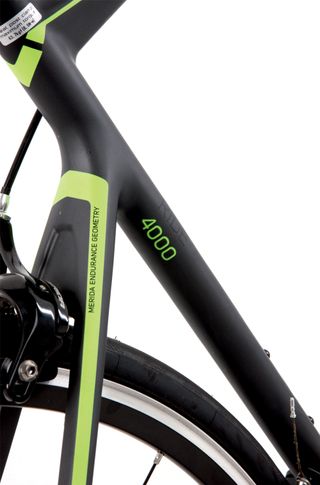Merida Ride 4000 review
Stylish mileage muncher offers an armchair ride. Tom Isitt rode the Merida Ride 4000

-
+
All day comfort
-
-
Ugly head tube
You can trust Cycling Weekly.
The second-biggest bike brand in the world (which also makes some Specialized models under contract), Merida has a lot of experience building bikes and a lot of clout when buying in components. This usually means the company offers good build quality and value for money. The Merida Ride 4000 is no exception.
The Ride series is Merida’s endurance/sportive range, and the Reacto, as ridden by the Lampre-Merida Pro Tour race team, is its pure race range, designed to be reasonably sporty but also offering all-day comfort. The Ride 4000 is pitched firmly at the rider looking to step up from entry-level aluminium to their first carbon bike.
Frameset
Merida’s size L frame, as tested here, is basically a 56cm frame with a stack-to-reach ratio of 1.61 (the stack is 611mm and the reach is 378mm). With fairly standard 73-degree seat and head tube angles, a head tube length of 215mm, and a wheelbase of 997mm, the net result is a frame perfect for the slightly less flexible rider in search of a reasonably upright riding position and a predictable steering response.
>>> The best cheap bikes: ridden and rated
The way the seatstays join the seat tube several centimetres below the top tube junction (and the use of a 27.2mm seatpost) allows for a little vertical flex in this area, adding to the overall comfort.

Components
In this price bracket, Shimano 105 is pretty much standard issue and the Merida comes with 105 everywhere apart from the brakes, which are Merida’s own-brand Road Pro calipers. That may suggest cost-cutting, but these own-brand brakes are almost as good as 105, so there’s little trade-off in terms of performance.
Interestingly, the Ride 4000 comes with a truly massive 11-32 rear cassette, which should get even the most unfit of us up any hill. The seatpost, bar and stem are all by Controltech and do the job perfectly well. Not so the own-brand saddle, which looks a bit cheap and feels rather, um, ‘planky’.
Wheels
The Merida Ride 4000 comes with Fulcrum Racing Comp wheels shod with Continental Ultra Sport 25mm tyres. It’s a solid, functional set-up from Fulcrum, a part of the Campagnolo group, and the Racing Comps are essentially the same as Fulcrum Racing 7 wheels.
They’re not the lightest, but they are strong and they should stand up to a fair amount of abuse. Merida has shod these with 25mm Contis, which seem to be de rigueur these days, but the rim is relatively narrow so you don’t get the full benefit from the wider tyres.
Riding
Riding the Ride 4000 is a pretty pleasant experience. If it were a car, it would be a Grand Tourer, capable of whisking you over significant distances in comfort and with the minimum of fuss. The endurance geometry and long (and very ugly) head tube means that you ride in a fairly relaxed, upright posture. Purists may tut and mutter about aerodynamics, but the fact that you don’t have to stop every hour to receive treatment from your chiropractor means that you can cover more miles more comfortably.
In terms of handling, there is little unwanted flex, so you can get the power down efficiently and maintain mid-corner speed. The steering geometry errs on relaxed, but that gives a solid, predictable steering response. As a long-distance mile-muncher, the Ride 4000 is very comfortable
and capable.

Thank you for reading 20 articles this month* Join now for unlimited access
Enjoy your first month for just £1 / $1 / €1
*Read 5 free articles per month without a subscription

Join now for unlimited access
Try first month for just £1 / $1 / €1
Get The Leadout Newsletter
The latest race content, interviews, features, reviews and expert buying guides, direct to your inbox!
-
 Overachiever: Cameron Wurf competed in the Amstel Gold, La Flèche Wallonne and an Ironman, all in just eight days
Overachiever: Cameron Wurf competed in the Amstel Gold, La Flèche Wallonne and an Ironman, all in just eight daysCameron Wurf is both a member of Team Ineos Grenadiers and an accomplished professional long course triathlete who has racked up numerous World Tour and Ironman race finishes across his career.
By Kristin Jenny Published
-
 Wout van Aert back on drop bars as he says he’s 'almost professional again' in Strava post
Wout van Aert back on drop bars as he says he’s 'almost professional again' in Strava postVisma-Lease a Bike rider broke his collarbone, sternum and several ribs in a high speed crash at Dwars door Vlaanderen
By Tom Thewlis Published
-
 'Ride like you own the road' - Zoe Bäckstedt on Paris-Roubaix Femmes, her Grand Tour debut and her new Red Bull helmet
'Ride like you own the road' - Zoe Bäckstedt on Paris-Roubaix Femmes, her Grand Tour debut and her new Red Bull helmetBäckstedt recently landed sponsorship from the energy drink giants and joined the likes of Tom Pidcock, Pauline Ferrand-Prévot and Evie Richards as a Red Bull athlete
By Tom Thewlis Published